|
First Battle of Kinston
Kinston and the Civil War
| Map of the route to Goldsboro |
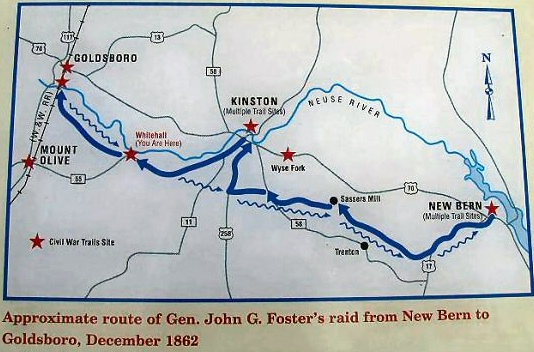
|
| General Foster's route from New Bern to Goldsboro |
The first battle of Kinston was part of a general troop movement by Union forces which
extended as far west as Goldsboro (Goldsboro Expedition), as far north as Fredericksburg, Va., and as
far south as Wilmington, North Carolina.
Union troops under the command of Brigadier General John G. Foster of New Hampshire had already
captured the town of New Bern. Foster's troops were estimated
at 15,000 to 30,000 supported by nine small gun boats on the Neuse
River. The Confederate forces, under the command of General Nathan "George"
Evans of South Carolina, were estimated by contemporary
newspaper accounts “3,000 to more than 6,000 men.” Evans, like Foster, was a West Point Military Academy
graduate. On Dec. 10, 1862, the advance of Union troops on Kinston
had begun.
| Battle of Kinston |
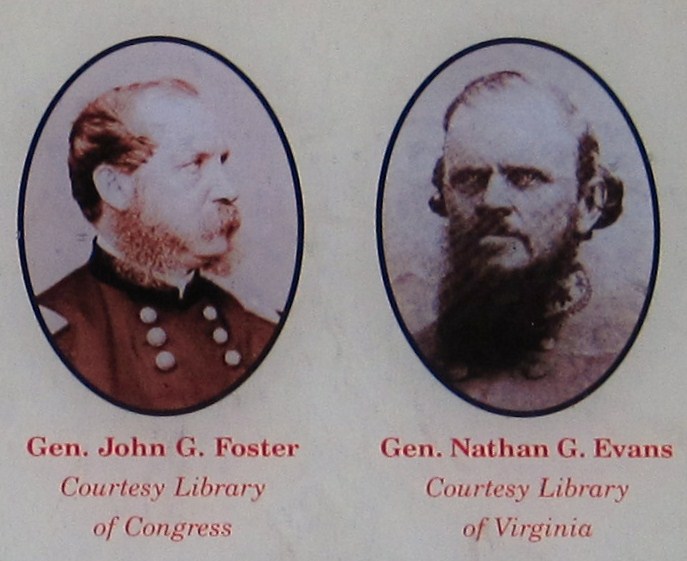
|
| Opposing Commanding Generals |
Commanding Generals during the Battle of Kinston
Union
Gen. John G. Foster (May 27, 1823 – September 22, 1874)
Confederate Gen. Nathan G. Evans (February 3, 1824 – November
23, 1868)
| Location of Kinston, North Carolina |
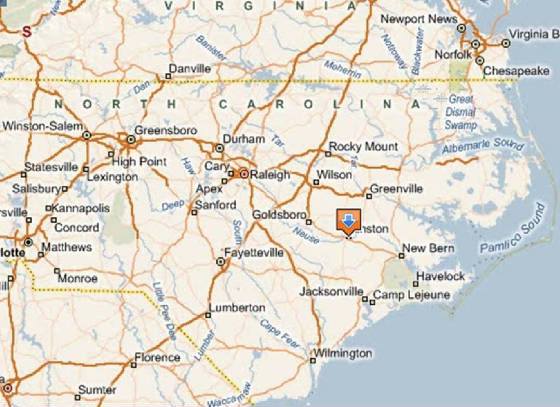
|
| (Map courtesy Microsoft Virtual Earth) |
Newspaper accounts of the
day present a vivid picture of the battle that ensued:
| First Battle of Kinston Map |
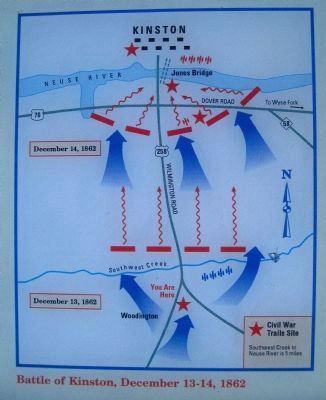
|
| (North Carolina Civil War Map) |
Newspaper accounts of the day
present a vivid picture of the battle that ensued:
Raleigh State Journal Dec.
12: "A courier just arrived from the picket lines brings a dispatch from Major Nethercutt, saying that he is pressed
by the enemy and is falling back towards Kinston. The abolitionists are advancing in large force. Report says the number is 17,000. It is reported Major Nethercutt lost 8 men
on yesterday evening, killed and captured. A dispatch received in this, city this morning states that the abolitionists have
attacked General Evans in force somewhere below Kinston."
The Raleigh Progress Dec.
13: "The enemy are advancing on the South side of the Neuse River. Fight progressing at half past 11. The enemy are within four miles of Kinston. The cannonading is distinctly heard here and is very rapid.
The result is unknown."
The cannonading reported in this
newspaper account was probably the result of a hurriedly laid trap to halt the advance of Union gunboats up the river.
The Confederates had constructed a series of obstructions in the river using stone and other materials to form jetties blocking
the shallow river from passage by the gunboats.
Trapped, the gunboats were shelled
by the Confederates as they tried to blast their way through the obstructions. Unfortunately for the Confederates, the only
cannonballs they possessed were of the “round solid type” which bounced off the heavy armor of the Union ships.
However, the diversion can be
called a success as the Union boats were unable to advance up the river and shell the town as was intended in their battle
plan.
| (A) New Bern to (B) Kinston Civil War Route Map |
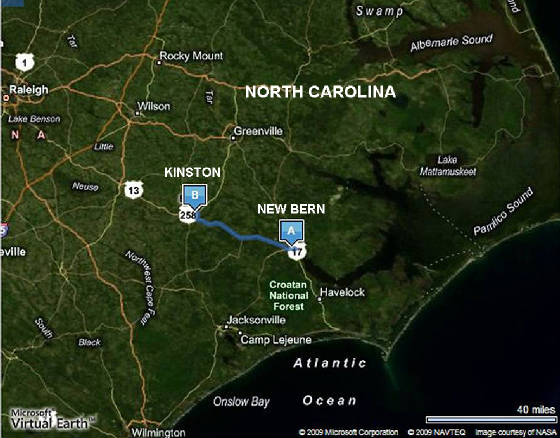
|
| Satellite view courtesy Microsoft Virtual Earth |
The State Journal Dec. 15: "On Sunday, December 14, the Union gunboats continued to batter away at the obstructions
in the river as Union troops advanced along the South Shore of the Neuse.
Gallantly the confederates were very hard fighting; we numbered less than 3,000 in the fight-the enemy at the lowest estimate
20,000. The battle commenced about nine o'clock and ended about 5 p.m. Our men fought with great spirit and not until they
were flanked on both sides did they retreat. The only open road left was over the bridge and after a portion had passed, an
attempt was made to fire the bridge, but it failed, and the enemy succeeded in crossing under heavy fire of our artillery.
We had 20 guns bearing down on the enemy, of which we lost three. Several of our men were burned and drowned in the attempts
to destroy the bridge. A number of our men were cut off from crossing, and it is thought were taken prisoners supposed
to be some hundreds, but it is doubtful as to the numbers. Evans forces retreated to Falling Creek, six miles north of Kinston as the Union Army marched into town. The remaining forces consisted
of six regiments and six pieces of artillery. Evans hoped to receive reinforcements at Falling Creek and soon drive Foster's
raiders from the town. Fortunately, for Kinston at least, the Union Forces pushed on to Goldsboro, and Kinston was spared an
attack by its own troops.” Continued below...
| First Battle of Kinston, North Carolina |
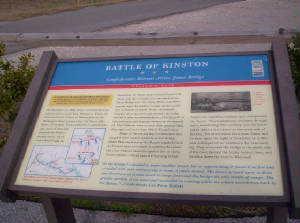
|
| (Click to Enlarge) |
Credit: historicalpreservationgroup.org
Recommended Reading: The Civil War in the Carolinas
(Hardcover). Description: Dan Morrill relates the experience
of two quite different states bound together in the defense of the Confederacy, using letters, diaries, memoirs, and reports.
He shows how the innovative operations of the Union army and navy along the coast and
in the bays and rivers of the Carolinas affected the general course of the war as well as
the daily lives of all Carolinians. He demonstrates the "total war" for North
Carolina's vital coastal railroads and ports. In the latter part of the war, he describes
how Sherman's operation cut out the heart of the last stronghold
of the South. Continued below...
The author
offers fascinating sketches of major and minor personalities, including the new president and state governors, Generals Lee,
Beauregard, Pickett, Sherman, D.H. Hill, and Joseph E. Johnston. Rebels and abolitionists, pacifists and unionists, slaves
and freed men and women, all influential, all placed in their context with clear-eyed precision. If he were wielding a needle
instead of a pen, his tapestry would offer us a complete picture of a people at war. Midwest Book Review: The Civil War in the Carolinas by civil war expert and historian
Dan Morrill (History Department, University of North Carolina at Charlotte, and Director of the Charlotte-Mecklenburg Historical
Society) is a dramatically presented and extensively researched survey and analysis of the impact the American Civil War had
upon the states of North Carolina and South Carolina, and the people who called these states their home. A meticulous, scholarly,
and thoroughly engaging examination of the details of history and the sweeping change that the war wrought for everyone, The
Civil War In The Carolinas is a welcome and informative addition to American Civil War Studies reference collections.
Recommended Reading: Ironclads and Columbiads: The Coast
(The Civil War in North Carolina) (456 pages). Description: Ironclads and Columbiads covers some of the most
important battles and campaigns in the state. In January 1862, Union forces began in earnest to occupy crucial points on the
North Carolina coast. Within six months, Union army and
naval forces effectively controlled coastal North Carolina from the Virginia
line south to present-day Morehead City.
Continued below...
Union setbacks in Virginia, however, led to the withdrawal of many federal soldiers from North Carolina,
leaving only enough Union troops to hold a few coastal strongholds—the vital ports and railroad junctions. The South
during the Civil War, moreover, hotly contested the North’s ability to maintain its grip on these key coastal strongholds.
Recommended Reading: Storm over Carolina: The Confederate
Navy's Struggle for Eastern North Carolina. Description: The struggle for control of the eastern waters of North Carolina during the War Between the States was a bitter, painful,
and sometimes humiliating one for the Confederate navy. No better example exists of the classic adage, "Too little, too late." Burdened
by the lack of adequate warships, construction facilities, and even ammunition, the South's naval arm fought bravely and even
recklessly to stem the tide of the Federal invasion of North Carolina from the raging Atlantic. Storm Over Carolina is the account of the
Southern navy's struggle in North Carolina waters and it
is a saga of crushing defeats interspersed with moments of brilliant and even spectacular victories. It is also the story
of dogged Southern determination and incredible perseverance in the face of overwhelming odds. Continued below...
For most of
the Civil War, the navigable portions of the Roanoke, Tar, Neuse, Chowan, and Pasquotank rivers were
occupied by Federal forces. The Albemarle and Pamlico sounds, as well as most of the coastal towns and counties, were also
under Union control. With the building of the river ironclads, the Confederate navy at last could strike a telling blow against
the invaders, but they were slowly overtaken by events elsewhere. With the war grinding to a close, the last Confederate vessel
in North Carolina waters was destroyed. William T. Sherman
was approaching from the south, Wilmington was lost, and the
Confederacy reeled as if from a mortal blow. For the Confederate navy, and even more so for the besieged citizens of eastern
North Carolina, these were stormy days indeed. Storm Over Carolina describes their story, their struggle, their history.
Recommended Reading: The Civil War
in Coastal North Carolina (175 pages) (North Carolina Division of Archives and History). Description: From the drama of blockade-running to graphic descriptions of battles
on the state's islands and sounds, this book portrays the explosive events that took place in North Carolina's coastal region during the Civil War. Topics discussed include the strategic
importance of coastal North Carolina, Federal occupation
of coastal areas, blockade-running, and the impact of war on civilians along the Tar Heel coast.
Recommended Reading: Confederate Military History Of North Carolina: North Carolina In The Civil War, 1861-1865. Description: The author, Prof. D. H. Hill, Jr., was the son of Lieutenant General Daniel Harvey
Hill (North Carolina produced only two lieutenant generals
and it was the second highest rank in the army) and his mother was the sister to General “Stonewall” Jackson’s
wife. In Confederate Military History Of North Carolina, Hill discusses North
Carolina’s massive task of preparing and mobilizing for the conflict; the many regiments and battalions recruited from
the Old North State; as well as the state's numerous contributions during the war. Continued below...
During Hill's
Tar
Heel State study, the reader begins with
interesting and thought-provoking statistical data regarding the 125,000 "Old
North State" soldiers that fought
during the course of the war and the 40,000 that perished. Hill advances with the Tar Heels to the first battle at Bethel, through numerous bloody campaigns and battles--including North Carolina’s
contributions at the "High Watermark" at Gettysburg--and concludes with Lee's surrender at
Appomattox.
|

